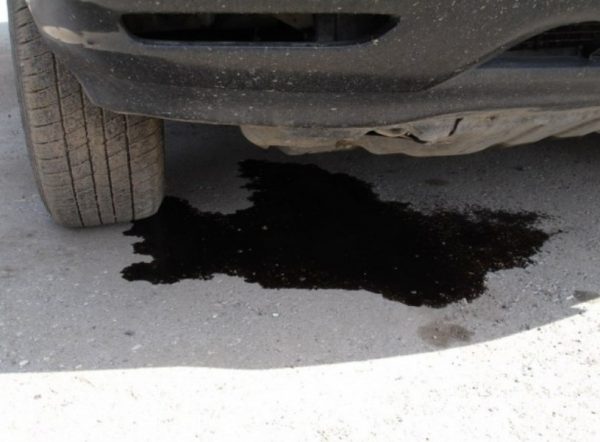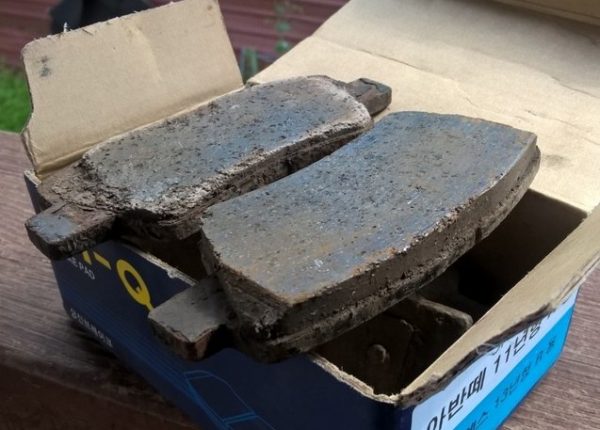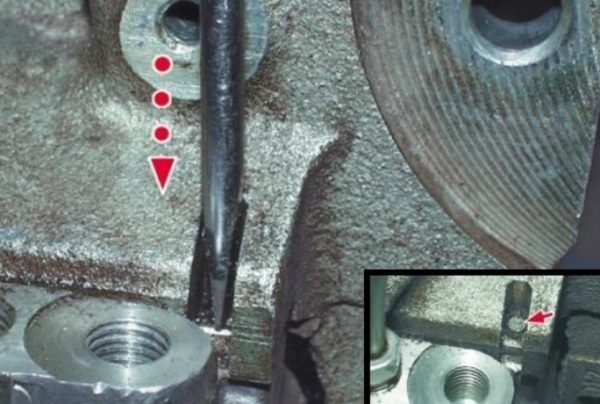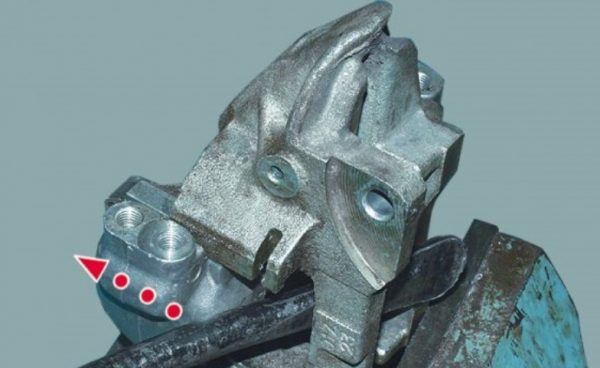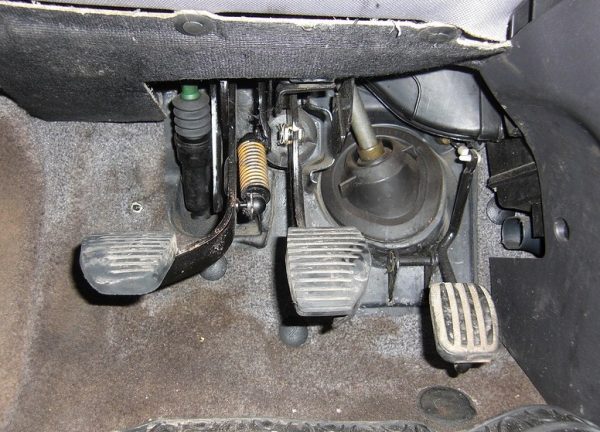
We independently pump the brakes on the VAZ 2106
Content
The brakes on the car must be in good working order. This is an axiom that is true for all cars, and the VAZ 2106 is no exception. Unfortunately, the braking system of this car has never been highly reliable. It regularly gives car owners a headache. However, most of the problems with the brakes can be solved by ordinary pumping. Let's try to figure out how it's done.
Typical malfunctions of the VAZ 2106 brake system
Since the VAZ 2106 is a very old car, the vast majority of problems with its brakes are well known to motorists. We list the most common.
Too soft brake pedal
At some point, the driver discovers that in order to apply the brakes, he does not need almost any effort: the pedal literally falls into the floor of the passenger compartment.

Here is a list of reasons why this happens:
- air has entered the brake system. It can get there in different ways, but usually this is due to a damaged brake hose or due to the fact that one of the brake cylinders has lost its tightness. The solution is obvious: first you need to find the damaged hose, replace it, and then eliminate excess air from the brake system by bleeding it;
- the brake master cylinder has failed. This is the second reason why the brake pedal falls to the floor. Identifying a problem with the master cylinder is quite simple: if the brake fluid level in the system is normal and there are no leaks either on the hoses or near the working cylinders, then the problem is probably in the master cylinder. It will have to be replaced.
Decreased brake fluid level
Bleeding the brakes may also be required when the level of brake fluid in the VAZ 2106 system has seriously dropped. This is why it happens:
- the owner of the car does not pay due attention to checking the brakes of his car. The fact is that the fluid from the tank can gradually leave, even if the brake system seems to be tight. It's simple: absolutely hermetic brake systems do not exist. Hoses and cylinders tend to wear out over time and begin to leak. These leaks may not be noticeable at all, but they slowly but surely reduce the overall fluid supply. And if the car owner does not add fresh fluid to the tank in time, then the effectiveness of the brakes will seriously decrease;
 Over time, small cracks appear on the brake hoses, which are not so easy to notice.
Over time, small cracks appear on the brake hoses, which are not so easy to notice. - drop in liquid level due to large leakage. In addition to hidden leaks, obvious leaks can always occur: one of the brake hoses can suddenly break due to both huge internal pressure and external mechanical damage. Or the gasket in one of the working cylinders will become unusable, and the liquid will begin to leave through the hole formed. This problem has only one plus: it is easy to notice. If the driver, approaching the car, saw a puddle under one of the wheels, then it’s time to call a tow truck: you can’t go anywhere in such a car.
 Do not drive if there is a large brake fluid leak.
Do not drive if there is a large brake fluid leak.
One wheel does not brake
Another typical problem with VAZ 2106 brakes is when one of the wheels refuses to slow down along with the rest. Here are the reasons for this phenomenon:
- if one of the front wheels does not slow down, then the reason is most likely in the working cylinders of this wheel. It is likely that they are stuck in the closed position. So they cannot move apart and press the pads against the brake disc. Cylinder sticking can be caused by dirt or rust. The problem is solved by cleaning or completely replacing the device;
- the lack of braking on one of the front wheels may also be due to the complete wear of the brake pads. This option is most likely when the driver uses fake pads that do not have soft metal in the protective coating. Counterfeiters usually save on copper and other soft metals, and use ordinary iron filings as a filler in pads. The protective coating of the block, made on the basis of such sawdust, quickly collapses. Along the way, it destroys the surface of the brake disc, covering it with potholes and scratches. Sooner or later there comes a moment when the wheel simply stops braking;
 Uneven brake pad wear leads to a severe reduction in braking performance.
Uneven brake pad wear leads to a severe reduction in braking performance. - lack of braking on one of the rear wheels. This is usually the result of a failure of the cylinder that pushes the c-pads into contact with the inner surface of the brake drum. And this may also be due to a broken spring that returns the pads to their original position. It may seem paradoxical, but it is a fact: if the pads do not return to the cylinder after the brakes are applied, they begin to hang out and constantly touch the inner wall of the brake drum. This leads to the destruction of their protective surface. If they wear out completely, then at the most crucial moment the wheel may not slow down, or braking will be very unreliable.
Replacing brake cylinders in VAZ 2106 calipers
The following must be said right away: repairing working cylinders on a VAZ 2106 is a completely thankless task. The only situation in which it is advisable to do this is corrosion or severe contamination of the cylinder. In this case, the cylinder is simply carefully cleaned of rust layers and installed in place. And if the breakdown is more serious, then the only option is to replace the cylinders, since it is not possible to find spare parts for them on sale. Here's what you need to work:
- a set of new brake cylinders for the VAZ 2106;
- flat screwdriver;
- locksmith's vice;
- a hammer;
- mounting blade;
- small scrap;
- wrenches, set.
Sequence of operations
To get to the damaged cylinder, you will first have to jack up the car and remove the wheel. Access to the brake caliper will open. This caliper will also need to be removed by unscrewing the two fixing nuts.
- After removal, the caliper is twisted into a metalwork vise. Using a 12 open-end wrench, a pair of nuts holding the hydraulic tube to the working cylinders is unscrewed. The tube is removed.
 To remove the tube, the caliper will have to be clamped in a vise
To remove the tube, the caliper will have to be clamped in a vise - On the side of the caliper there is a groove in which there is a retainer with a spring. This latch is moved down with a flathead screwdriver.
 You will need a very long flathead screwdriver to dislodge the latch.
You will need a very long flathead screwdriver to dislodge the latch. - While holding the latch, you should gently hit the cylinder several times with a hammer in the direction shown by the arrow in the picture.
 To knock the cylinder to the left, it is better to use a small wooden hammer
To knock the cylinder to the left, it is better to use a small wooden hammer - After a few blows, the cylinder will shift and a small gap will appear next to it, where you can insert the edge of the mounting blade. Using the spatula as a lever, the cylinder needs to be moved a little more to the left.
- As soon as the gap next to the cylinder becomes even wider, a small crowbar can be inserted into it. With its help, the cylinder is finally pushed out of its niche.
 As soon as the gap next to the cylinder becomes wide, you can use the crowbar as a lever
As soon as the gap next to the cylinder becomes wide, you can use the crowbar as a lever - The broken cylinder is replaced with a new one, after which the VAZ 2106 brake system is reassembled.
Video: change the brake cylinder "six"
We change the main cylinder of brakes VAZ 2106
Like the slave cylinders, the brake master cylinder cannot be repaired. In the event of a breakdown of this part, the only reasonable option is to replace it. Here is what is needed for this replacement:
- new master brake cylinder for VAZ 2106;
- open-end wrenches, set;
- flat screwdriver.
Sequence of operations
Before starting work, you will have to drain all the brake fluid from the system. Without this preparatory operation, it will not be possible to change the master cylinder.
- The engine of the car is turned off. You need to let it cool down completely. After that, the hood opens and the fastening belt is removed from the brake reservoir. Next, with a 10 key, the tank mounting bolts are unscrewed. It is removed, the liquid from it is drained into a previously prepared container.

 To remove the tank, you first have to unfasten the belt that holds it.
To remove the tank, you first have to unfasten the belt that holds it. - Hoses are attached to the brake fluid reservoir. They are attached there with tape clamps. The clamps are loosened with a screwdriver, the hoses are removed. Opens access to the master cylinder.
- The cylinder is attached to the vacuum brake booster with two bolts. They are unscrewed with a 14 wrench.

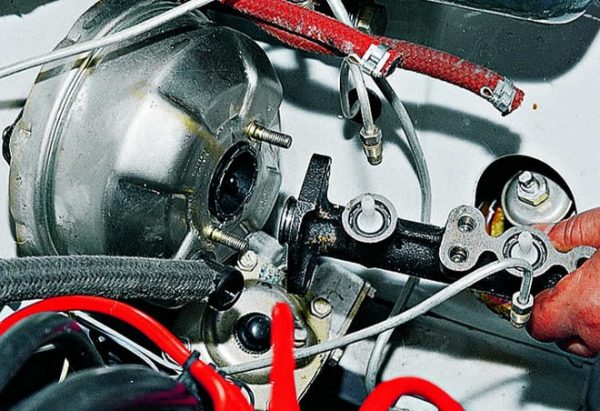 The main brake cylinder of the "six" rests on just two bolts
The main brake cylinder of the "six" rests on just two bolts - The brake cylinder is removed and replaced with a new one. After that, the tank is installed in place and a new portion of brake fluid is poured into it.
Replacing brake hoses on a VAZ 2106
The safety of the VAZ 2106 driver depends on the condition of the brake hoses. So at the slightest suspicion of a leak, the hoses should be changed. They are not subject to repair, because the average driver simply does not have the right equipment in the garage to repair such critical parts. To change the brake hoses, you need to stock up on the following things:
- a set of new brake hoses for the VAZ 2106 (the cost starts from 2 thousand rubles);
- special wrench for brake hoses;
- set of open-end wrenches.
Sequence of work
You will have to remove the hoses one by one. This means that the wheel on which the brake hose is planned to be replaced will first have to be jacked up and removed.
- After removing the front wheel, access to the nuts holding the hose to the front caliper is revealed. These nuts must be unscrewed using a special hose wrench. In some cases, the nuts are heavily oxidized and literally stick to the caliper. Then you should put a small piece of pipe on the hose wrench and use it as a lever.

 To remove the front hose, you will have to use a special wrench.
To remove the front hose, you will have to use a special wrench. - Similar actions are performed with the second front wheel to remove the second hose.

 The front hose is held on by just two nuts, which are unscrewed with hose wrenches.
The front hose is held on by just two nuts, which are unscrewed with hose wrenches. - To remove the rear hose from the drum brakes, the car will also have to be jacked up and the wheel removed (although the second option is also possible here: removing the hose from below, from the inspection hole, but this method requires a lot of experience and is not suitable for a novice driver).
- The rear hose is installed in a special bracket with a fixing bracket, which is removed with ordinary pliers.

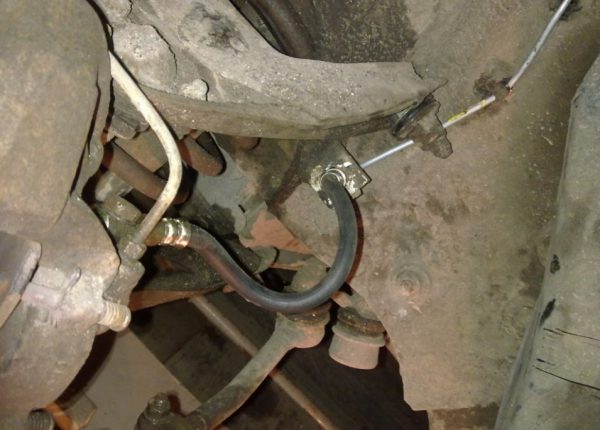 To remove the rear brake hose, you will need a pair of open-end wrenches - 10 and 17
To remove the rear brake hose, you will need a pair of open-end wrenches - 10 and 17 - Opens access to the hose fitting. This fitting is fixed with two nuts. To remove it, you need to hold one nut with an open-end wrench by 17, and unscrew the second nut by 10 along with the fitting. The other end of the hose is removed in the same way.

 The rear brake hose on the "six" rests on four nuts
The rear brake hose on the "six" rests on four nuts - The removed hoses are replaced with new ones from the kit, the wheels are installed in place and the car is removed from the jacks.
About brake fluid
The owner of the VAZ 2106, who is engaged in the repair of brakes, will definitely have to drain the brake fluid. Consequently, later the question will arise before him: how to replace it, and how much liquid to fill in? For the normal functioning of the VAZ 2106 brakes, 0.6 liters of brake fluid is required. That is, a driver who has completely drained the liquid from the system will have to buy a liter bottle. Now let's take a closer look at the types of liquid. Here they are:
- DOT3 grade fluid. The basis of this fluid is glycol, to which a package of special additives has been added to combat corrosion of the brake system. The main disadvantage of liquids of this type is their poor resistance to low temperatures, which is especially important for our country. As soon as the temperature drops below 40°C, DOT3 fluids become very viscous and braking performance is greatly reduced. Hence the conclusion: if the machine is operated in regions with a cold climate, the use of DOT3 class fluids should be refrained from;

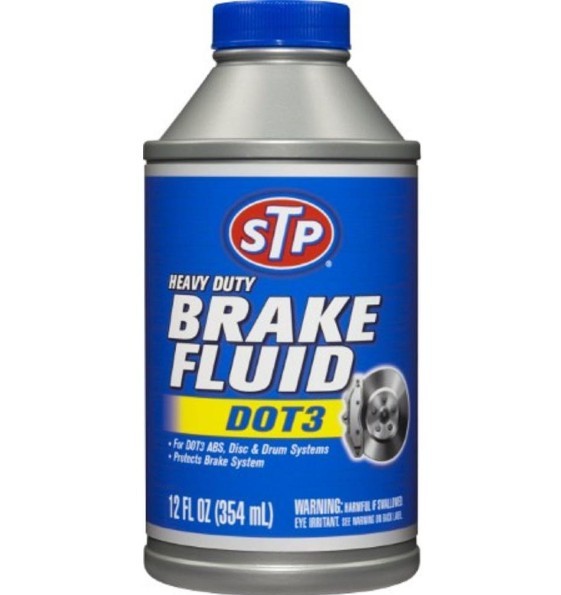 STP fluid is in demand, but it has a sharp increase in viscosity in the cold
STP fluid is in demand, but it has a sharp increase in viscosity in the cold - DOT4 grade fluid. The basis of the liquid is still the same glycol, however, the additives are selected in such a way as to increase the boiling point of the liquid. This feature of DOT3 fluid makes it suitable for use in race cars and in vehicles that prefer an extremely aggressive driving style. If the owner of the VAZ 2106 is not fond of anything like this, then the use of DOT3 fluid can hardly be called appropriate;

 Sintec fluid is more suitable for racing cars than for the usual "six"
Sintec fluid is more suitable for racing cars than for the usual "six" - DOT5 grade fluid. It is the best option for a VAZ 2106 car operated in any region of our country. First of all, the basis of DOT5 is not glycol, but silicone. And additives to this liquid significantly increase the temperature range of its operation: from +260°С to -70°С. As long as the temperature of the brake system has not gone beyond these limits, the viscosity of the brake fluid does not change and is 800 square meters. mm/s The most popular among the owners of the VAZ 2106 is BelRay products, which are of high quality and affordable price: a 350 ml bottle will cost the driver 700 rubles.

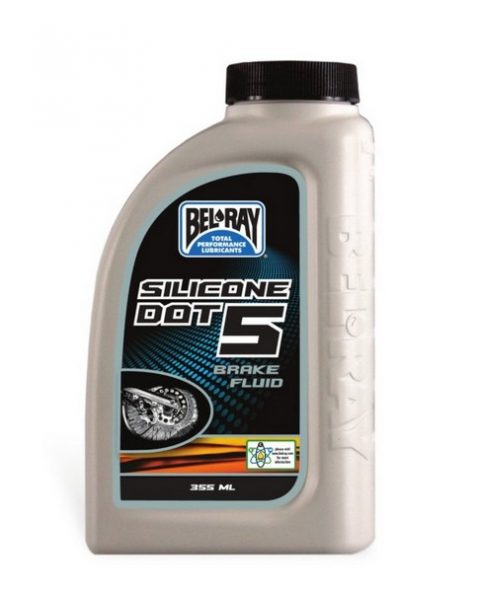 BelRay brake fluid is very popular with the owners of the "classics"
BelRay brake fluid is very popular with the owners of the "classics"
About mixing brake fluids
Speaking of brake fluids, one cannot help but touch on another important question that sooner or later arises before every novice motorist: is it possible to mix brake fluids? In short, it is possible, but not desirable.
Now more. There are situations when it is urgent to add a little DOT5 class brake fluid to the system, but the driver has only DOT3 or DOT4 available. How to be? The rule is simple: if there is no way to fill the system with liquid of the same brand, you should fill in liquid on the same basis. If a silicone-based liquid circulates in the system, you can fill in silicone, although of a different brand. If the liquid is glycol (DOT4) - you can fill in another glycol (DOT3). But this can be done only as a last resort, since even liquids with the same base will have a different set of additives. And mixing the two sets can lead to premature wear of the brake system.
Bleeding the brake system VAZ 2106
Before starting work, you should remember that the brakes on the VAZ 2106 are pumped in a certain order: the right wheel is pumped first at the back, then the left wheel is at the back, then the right wheel is in front and the left is in front. Violation of this order will lead to the fact that air will remain in the system, and all work will have to be started anew.


In addition, swing the brakes should be with the help of a partner. Doing this alone is very difficult.
Sequence of operations
First, preparation: the car should be driven onto a flyover or into a viewing hole and put on the handbrake. This will make it easier to access the brake fittings.
- The hood of the car opens. The plug is unscrewed from the brake reservoir, and the fluid level in it is checked. If there is little liquid, it is added to the mark on the reservoir.

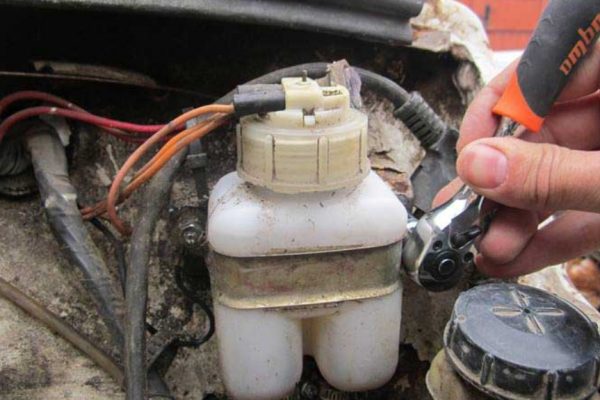 The liquid in the tank should reach the top edge of the horizontal metal strip.
The liquid in the tank should reach the top edge of the horizontal metal strip. - The assistant sits in the driver's seat. The owner of the car descends into the inspection hole, puts a key on the brake fitting of the rear wheel. Then a small tube is put on the fitting, the other end of which is lowered into a bottle of water.
- The assistant presses the brake pedal 6-7 times. In a working brake system, with each press, the pedal will fall deeper and deeper. Having reached the lowest point, the assistant holds the pedal in this position.
- At this time, the car owner unscrews the brake fitting with an open-end wrench until brake fluid flows from the tube into the bottle. If there is an air lock in the system, the fluid that flows out will bubble strongly. As soon as the bubbles stop appearing, the fitting is twisted into place.

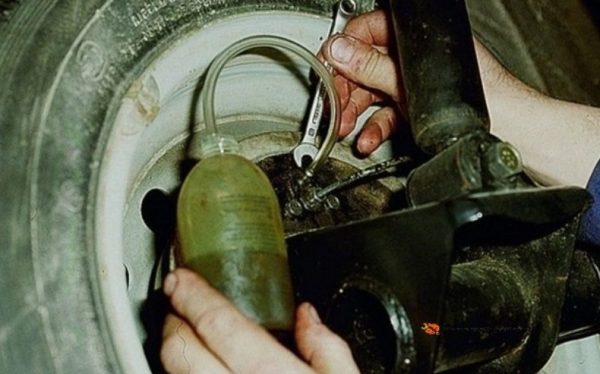 Pumping continues until no more air bubbles come out of the tube into the bottle.
Pumping continues until no more air bubbles come out of the tube into the bottle. - This procedure is done for each wheel in accordance with the scheme mentioned above. If everything is done correctly, there will be no air pockets in the system. And all the car owner needs to do is add a little more brake fluid to the reservoir. After that, the pumping procedure can be considered completed.
Video: we pump the VAZ 2106 brakes alone


Watch this video on YouTube
Causes of problems with pumping brakes VAZ 2106
Sometimes the driver is faced with a situation where the brakes on the VAZ 2106 simply do not pump. Here's why it's happening:
- violation of the order of pumping. This is the most common reason for unsuccessful bleeding of the brakes on the "six". Novice drivers forget that the brakes on the VAZ 2106 are dual-circuit, and therefore it is very important to follow the bleeding scheme. And if you start pumping from the front wheels, and not from the rear, then it will be simply impossible to expel all the air from the system;
- poor quality brake fluid. It's no secret that in the modern market of fuels and lubricants there is a huge number of fakes, and, as a rule, products of the most popular brands are faked. Brake fluid is no exception. If the driver is “lucky” to buy just such a liquid, then its viscosity can increase very much over time. In especially severe cases, fake brake fluid thickens so much that it begins to resemble grease in consistency. Of course, there can be no talk of any normal pumping of the brakes in this case. The brake system will have to be disassembled and thoroughly cleaned.
So, the life of the driver and his passengers depends on the condition of the brakes of the "six". Therefore, it is his direct responsibility to keep them in good condition. Fortunately, most troubleshooting operations can be done on your own in your garage. All you need to do is follow the instructions above exactly.



